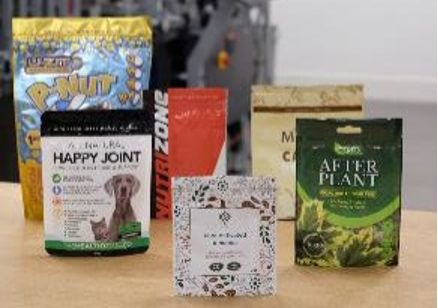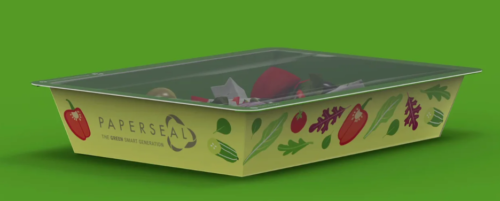This is the second article in our series to explore sustainability and its impact on inkjet printing and innovation (see previous). The pressure is mounting for companies to offer sustainable products and for companies themselves to be sustainable. This article explores opportunities for inkjet by exploring a sampling of brand sustainability goals and then shows examples of recently launched packages with the capabilities to support brand sustainability goals. Examples span multiple industries including personal care, home furnishings and quick service restaurants.
The Big Picture
A leader influencing change in the packaging industry is The Ellen MacArthur Foundation, an NGO focused on the circular economy. In late 2018, The Ellen MacArthur Foundation collaborated with the UN Environment Programme to establish the New Plastics Economy Commitment. More than 500 companies throughout the supply chain have signed on in support of the Vision:
Elimination of problematic or unnecessary plastic packaging through redesign, innovation, and new delivery models is a priority
- Reuse models are applied where relevant, reducing the need for single-use packaging
- All plastic packaging is 100% reusable, recyclable, or compostable
- All plastic packaging is reused, recycled, or composted in practice
- The use of plastic is fully decoupled from the consumption of finite resources
- All plastic packaging is free of hazardous chemicals, and the health, safety, and rights of all people involved are respected.
Brand Examples
The following brands are leaders in their respective industries of personal care products, home furnishings and quick service restaurants. Each has defined sustainability goals related to the New Plastics Economy Commitment. Brand goals such as these are likely to drive digital print innovation in packaging.
Colgate Palmolive
A $15+ billion global consumer products company, Colgate Palmolive lists “People and Sustainability Strategies” as one of the organization’s top priorities in its Investor Presentation. Listed on the Dow Jones Sustainability Index and a member of the Ellen MacArthur Foundation, Colgate Palmolive has published 2025 Plastic Commitments to use 100% recyclable plastics (defined as reusable and/or compostable) in all categories. In addition, the plastics it uses must contain at least 25% recycled content. Colgate Palmolive states it has improved the sustainability profile in 99% of new products, further underlining the importance sustainability will continue to play in global consumer products innovation in the years to come.
Packaging Example

Source: Colgate Palmolive
IKEA
IKEA has published that by 2030, all plastic used in the company’s products will be based on renewable or recycled material. As a start, the $25+ billion home furniture retailer has a plan to replace single-use plastic and to use different kinds of sustainable plastic in an increasing number of products. The organization states that sustainable plastic is made from renewable, bio-based resources such as corn, sugar beet, and sugar cane versus virgin fossil fuels. IKEA lists PLA as an example of a sustainable plastic.
McDonald’s
McDonald’s has published multiple sustainability goals. By 2030, the global quick service restaurant leader expects to prevent 150 million tons of greenhouse gas emissions from being released into the atmosphere. In 2020, it debuted a unique restaurant designed to generate enough renewable energy on-site to cover 100% of its own energy needs on a net annual basis. More specific to packaging, McDonald’s states they are 78% of the way toward their goal to source all packaging from renewable recycled and certified sources by 2025. Further investment is underway to develop recyclable cups.
Printed Product Examples
The following is a sampling of recently announced print on packaging that is promoted as more sustainable than traditional alternatives. All but one example is digitally printed. The analog print example was included to demonstrate an example of package design and substrate change.
Epac – Epac published a case study in May 2021 showcasing a digitally printed recyclable film package for freeze dried fruits. This replaces the traditional plastic stand-up pouch with a recyclable alternative enabling brands to meet 2025 New Plastics Economy Commitments.

CS Labels – Xeikon highlighted digital stand-up pouch innovation at its recent Xeikon Café where CS Label uses Xeikon’s dry toner print technology to offer brands less waste versus conventional printing.

2020 Xeikon Café Presentation
Graphic Packaging International – Graphic Packaging International launched the PaperSeal® Skin Tray. It replaced single-use plastic trays with a barrier lined paper-board alternative reducing plastic by up to 90% versus traditional trays. Today, these trays are offset printed.

Bay Cities Packaging – Bay Cities Packaging announced in late 2020 that it is utilizing a Barberan Jetmaster 1750 to print corrugated sheets. INX, A Sakata INX Company, provides the consumables. INX BSR-06 is a bio-based UV inkjet ink that enables recyclability. The primer is water based and goes straight from the container to printer for an in-line priming system that does not need additional adjustments.

https://www.youtube.com/watch?v=JW_qTy0yS38
What It Means for Inkjet
Changing plastics – whether changing the type of plastic, reducing the amount of plastic or converting to paper – is a substrate change. Inks and coatings manufacturers will invest in innovation of new inks and coatings that are optimized for new substrates and contribute to brand sustainability goals. As one example, Smithers, a market research firm based in the United Kingdom states that bio-based materials innovation will occur in all areas of inks and coatings through 2026 driving a $2.7 billion increase in the bio-based inks and coatings market. Smithers also indicates that while inkjet is the fastest growing print technology, it is the one currently investing the least in bio-based innovation. An opportunity?
Water based inkjet technology has struggled to gain adoption on plastic package printing due to challenges around adhesion to the polar substrate and a need for additional drying to get the water out. Additional drying needs may go against brand desires to lower carbon footprint through more efficient energy utilization.
Where plastic printing is needed, opportunities may arise for UV and Indigo printing where adhesion and ink dry time have been a non-issue. One example is rigid containers shifting to pouches as shown in several of the examples. As plastic substrates are converted to paper, water based inkjet has opportunities to shine as the porous substrate helps to adsorb the water removing barriers to ink dry time and adhesion. An example is the use of inkjet printing on corrugated boxes and displays. UV inkjet is also growing in inkjet for corrugated boxes and displays and as INX exhibited in the example above, can be produced with bio-based materials.
Do you have other examples of digitally printed sustainable packaging? Send them our way.
Sources:
Only more sustainable plastic at IKEA by 2030 – IKEA
a65490ac-2442-41e3-8751-e18a1471bd92 (colgatepalmolive.com)
Global Commitment 2020 Progress Report (ellenmacarthurfoundation.org)
Circular economy vision for plastic pollution (ellenmacarthurfoundation.org)
Packaging & Waste (mcdonalds.com)
https://epacflexibles.com/snacking-on-the-go-with-sustainable-pouches-in-hand/
https://www.youtube.com/watch?v=JW_qTy0yS38
https://www.inxinternational.com/news/sakata-inx-develops-new-environmentally-friendly-uv-inkjet-ink-corrugated-packaging

